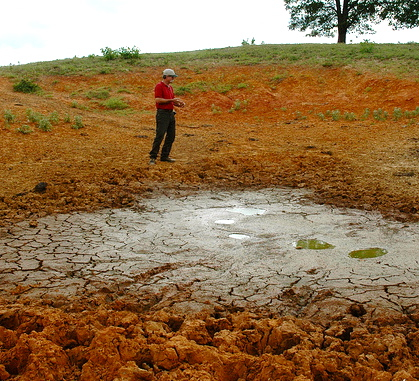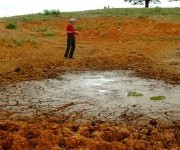 This pond in Texas dried out by late June.Photo: agrilifetodayVery few urban dwellers have paid attention to the catastrophic drought in the Southwest that began nearly a year ago. But last month, as farmers and ranchers assessed the year’s harvest, it became clear it had knocked back their yields and sales, while driving their costs higher than they have ever been. As the drought continues to drive both meat and vegetable food prices up over the next year, urbanites in the region and beyond will likely notice the change in prices; but whether they will make the connection between drought, climate change, and food security is another question.
This pond in Texas dried out by late June.Photo: agrilifetodayVery few urban dwellers have paid attention to the catastrophic drought in the Southwest that began nearly a year ago. But last month, as farmers and ranchers assessed the year’s harvest, it became clear it had knocked back their yields and sales, while driving their costs higher than they have ever been. As the drought continues to drive both meat and vegetable food prices up over the next year, urbanites in the region and beyond will likely notice the change in prices; but whether they will make the connection between drought, climate change, and food security is another question.
Since April, the mainstream media has offered occasional sound bites about how the drought in Texas was affecting food production. Ironically, these early alerts occurred even as that state’s presidential hopeful, Rick Perry, insisted that climate change was no more than a hypothesis. But most reporters failed to notice that the Rio Grande and its tributaries had gone dry from southern New Mexico, through west Texas, clear down to the Sierra Madre. By early fall, so many of Perry’s home state farmers and ranchers were in peril that their governor requested federal aid for disaster relief, as if drought and climate change were always two separate issues, and federal relief were not a federal intervention in state affairs.
But what mainstream media has failed to cover is the drought’s more pervasive, international effects. For starters, many subsistence farmers in northern Mexico have had barely enough maize left to feed their families this year, let alone enough surplus corn to sell. While this single but pervasive drought cannot be firmly linked to longer-term global climate change, it may nevertheless be a harbinger of what is to come in terms of the disruption of food security.  Summer 2011.To be sure, there are many factors that affect the prices of staple foods, including irresponsible speculation in the agricultural commodities markets, and the shunting of 38 percent of the American corn crop into the subsidized production of ethanol. But when I interviewed farmers and livestock producers in New Mexico and Texas near the Mexico border recently, it was clear that nearly a year of unquenchable drought was wreaking havoc on both the economic and ecological stability of the borderlands food system.
Summer 2011.To be sure, there are many factors that affect the prices of staple foods, including irresponsible speculation in the agricultural commodities markets, and the shunting of 38 percent of the American corn crop into the subsidized production of ethanol. But when I interviewed farmers and livestock producers in New Mexico and Texas near the Mexico border recently, it was clear that nearly a year of unquenchable drought was wreaking havoc on both the economic and ecological stability of the borderlands food system.
After 40 years of living in the borderlands, I was stunned to see, for the first time ever, a completely dry riverbed where the Rio Grande usually flows. Chile, pecan, and alfalfa growers who normally receive five to seven deliveries of diverted river water for irrigation purposes received just one this summer. Near Las Cruces and El Paso, so many farmers had to rely on pumping groundwater to save their crops that groundwater levels dropped to half their normal depth after just one year of additional extraction. Both the states of Texas and New Mexico received an unprecedented number of requests for permits to drill more wells and pump from already-vulnerable aquifers. And just having to pump water from wells rather than receive gravity-fed deliveries cost vegetable and hay farmers an average of 30 percent more.
 When pasture is too dry to provide nourishment, ranchers resort to alternative feed, like these protein cubes — an expensive option.Photo: agrilifetodaySmall and midsize ranchers and sheepherders may have lost even more; as their rangelands dried out, they could simply not sustain their herds and flocks. One well-known New Mexican sheepherder had to sell off his entire flock and went out of business. Texas and Oklahoma ranchers prematurely sold off more than 600,000 head of cattle because they could not maintain them — neither on the range nor by feeding them supplemental hay. And, to top it off, alfalfa hay prices have risen from $100 to $400 a ton since last October, placing most of the quality hay out of reach for all but the wealthiest dairymen and stockmen.
When pasture is too dry to provide nourishment, ranchers resort to alternative feed, like these protein cubes — an expensive option.Photo: agrilifetodaySmall and midsize ranchers and sheepherders may have lost even more; as their rangelands dried out, they could simply not sustain their herds and flocks. One well-known New Mexican sheepherder had to sell off his entire flock and went out of business. Texas and Oklahoma ranchers prematurely sold off more than 600,000 head of cattle because they could not maintain them — neither on the range nor by feeding them supplemental hay. And, to top it off, alfalfa hay prices have risen from $100 to $400 a ton since last October, placing most of the quality hay out of reach for all but the wealthiest dairymen and stockmen.
As one rancher explained to me, “You can’t really save the value of your herd during a drought by purchasing emergency feed … it will never pencil out for you to make a profit.”
Ironically, if the drought had not occurred this year, ranchers on both sides of the border could have sold beef at higher prices than they have for decades, since there is less meat being produced in North America than there has been at any time since World War II. This shortage will keep beef prices high for at least the next three to five years. But on the Mexican side of the border, the opportunity to benefit from this bubble has already been lost. Tens of thousands of cattle have died of hunger since March, because there is no supplemental feed to be had.
With a modicum of black humor, Mexican-American alfalfa growers have put handmade signs up on their gates that simply say “No hay” (meaning “There is none” in Spanish).
The effects of just one year’s worth of aberrant weather in the U.S./Mexico borderlands — both severe freezes and prolonged drought — may again remind us how vulnerable our own food security is.
Since 70 percent of the fresh vegetables eaten in the U.S. during the winter months comes from northern Mexico, and our beef and corn markets are highly dependent on one another, American consumers will surely face higher food prices over the next year.
And while many consumers don’t feel like they can afford to pay more for food, perhaps it’s up to those who have that capacity to pledge to farmers and ranchers that they will pay for the true costs of producing our food. It is, of course, farmers and ranchers who bear most of the brunt of the vagaries in our food system. Helping urban residents gain affordable access to healthy food may be only one part of the food justice picture; rural food producers will increasingly need to spread the risks they currently shoulder across the entire food supply chain. From now on, land health and human health at both ends of the chain need to be more strongly linked. That may ultimately be the only way we heal the urban/rural divide that has made so many of America’s food systems dysfunctional over the last half century.




